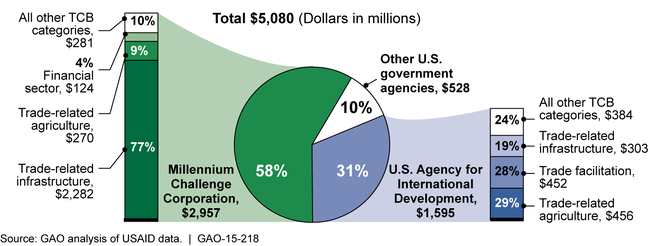African Growth and Opportunity Act: USAID Could Enhance Utilization by Working with More Countries to Develop Export Strategies
Highlights
What GAO Found
Among U.S. agencies, the Millennium Challenge Corporation (MCC) and the U.S. Agency for International Development (USAID) have funded the majority of trade capacity building (TCB) assistance in support of the African Growth and Opportunity Act (AGOA) (see figure). MCC obligated nearly $3 billion in funding for TCB activities in 15 of the 41 countries eligible for AGOA (AGOA countries), with the majority of funds provided for trade-related infrastructure projects. For example, MCC obligated $176 million for a roads project in Mozambique that aimed to improve the transportation network, including access to markets and reduction of transport costs. USAID obligated approximately $1.6 billion in funding for TCB activities in 39 of the 41 AGOA countries, with the majority of funds provided for trade-related agriculture and infrastructure, and trade facilitation. For example, USAID funded activities to help exporters in East Africa build business linkages with U.S. markets through trade shows.
U.S. Trade Capacity Building (TCB) Funding Obligated for African Growth and Opportunity Act Countries by Category, 2001-2013

Note: Funding amounts or percentages may not sum to totals because of rounding.
USAID has worked with some host governments to develop strategic approaches to AGOA utilization; however, most host governments have not established such approaches. USAID-funded regional trade hubs in sub-Saharan Africa have supported AGOA utilization by, among other things, collaborating with some host governments to develop AGOA-specific or broader national export strategies. Trade hub evaluations and statements from host government officials show that identifying strategic needs and priorities through strategic approaches can bolster AGOA utilization and help assess challenges to expanding exports. In strategy documents, host governments may identify high-priority trade and investment sectors, constraints related to AGOA utilization, and specific steps to increase exports under AGOA. Lack of a strategic approach has been identified as a significant reason for gaps in AGOA utilization. As of December 2014, 14 of the 41 AGOA countries had strategies reflecting AGOA priorities. According to USAID officials, host governments must initiate the process of developing a strategy, and a lack of political will may pose challenges to such efforts.
Why GAO Did This Study
Signed in 2000, AGOA directs the President to provide TCB assistance to sub-Saharan African governments and firms to promote exports and develop infrastructure, among other things. AGOA provides duty-free access on qualifying U.S. imports from eligible sub-Saharan African countries, a total of 41 countries as of December 1, 2014. From 2001 through 2013, U.S. agencies funded about $5 billion in TCB assistance to AGOA countries. GAO was asked to review various issues related to the ability of AGOA countries to utilize AGOA prior to its expiration on September 30, 2015.
In this report, GAO examines (1) U.S. government TCB assistance in support of AGOA, and (2) the extent to which USAID has made efforts to develop strategic approaches to AGOA utilization. GAO focused on MCC and USAID because these two agencies accounted for nearly 90 percent of funding for TCB activities in AGOA countries from 2001 through 2013. GAO analyzed data on U.S. TCB assistance to AGOA countries in this period, reviewed agencies' funding and program documents, conducted interviews with officials who implement U.S. TCB assistance, and met with U.S. and foreign government officials and private sector representatives in Ethiopia and Ghana.
Recommendations
GAO recommends that the Administrator of USAID work with more host governments to develop strategic approaches to promoting exports under AGOA. USAID agreed with the recommendation.
Recommendations for Executive Action
| Agency Affected | Recommendation | Status |
|---|---|---|
| U.S. Agency for International Development | To enhance eligible countries' ability to utilize the AGOA program and ensure that TCB assistance is aligned with program objectives, the Administrator of USAID should work with more host governments to develop strategic approaches to promoting exports under AGOA. | In August 2016, USAID provided information that shows the agency has engaged with host governments and developed further strategic approaches to implementing AGOA, as GAO intended with its recommendation. According to a USAID official, all three of the USAID trade hubs in Sub-Saharan Africa have engaged with host governments on efforts related to strategy development. The trade hub in East Africa worked with Rwanda and Tanzania to finalize strategies, and provided assistance related to AGOA utilization to the East African Community. According to a USAID official, the trade hub in southern Africa has plans to work with Botswana on its AGOA related strategy. The agency official also said... that the trade hub in West Africa provided input into Benin's AGOA Action Plan and given various types of support to Togo's national committee on AGOA. As the USAID official noted, USAID took these steps in response to GAO's recommendation. Other examples of the U.S. government's efforts to further support AGOA-related strategies exist. In its June 2016 AGOA report to Congress, the Office of the U.S. Trade Representative (USTR) cited the Administration's support of the development of AGOA utilization strategies. The USTR report also referred to 2015 AGOA legislation that encouraged the strategy development. In consideration of the above efforts that address the intent of the recommendation to further U.S. and host government efforts AGOA-related strategic thinking, GAO is considering this recommendation closed.
View More |
